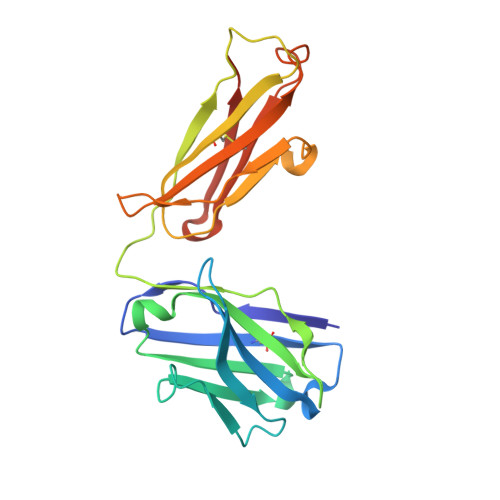Molecular evolution of antibody cross-reactivity for two subtypes of type A botulinum neurotoxin.
Garcia-Rodriguez, C., Levy, R., Arndt, J.W., Forsyth, C.M., Razai, A., Lou, J., Geren, I., Stevens, R.C., Marks, J.D.(2007) Nat Biotechnol 25: 107-116
- PubMed: 17173035
- DOI: https://doi.org/10.1038/nbt1269
- Primary Citation of Related Structures:
2NYY, 2NZ9 - PubMed Abstract:
Broadening antibody specificity without compromising affinity should facilitate detection and neutralization of toxin and viral subtypes. We used yeast display and a co-selection strategy to increase cross-reactivity of a single chain (sc) Fv antibody to botulinum neurotoxin type A (BoNT/A). Starting with a scFv that binds the BoNT/A1 subtype with high affinity (136 pM) and the BoNT/A2 subtype with low affinity (109 nM), we increased its affinity for BoNT/A2 1,250-fold, to 87 pM, while maintaining high-affinity binding to BoNT/A1 (115 pM). To find the molecular basis for improved cross-reactivity, we determined the X-ray co-crystal structures of wild-type and cross-reactive antibodies complexed to BoNT/A1 at resolutions up to 2.6 A, and measured the thermodynamic contribution of BoNT/A1 and A2 amino acids to wild-type and cross-reactive antibody binding. The results show how an antibody can be engineered to bind two different antigens despite structural differences in the antigen-antibody interface and may provide a general strategy for tuning antibody specificity and cross-reactivity.
Organizational Affiliation:
Department of Anesthesia and Pharmaceutical Chemistry, University of California, San Francisco Rm. 3C-38, San Francisco General Hospital, 1001 Potrero Ave., San Francisco, California 94110, USA.


















